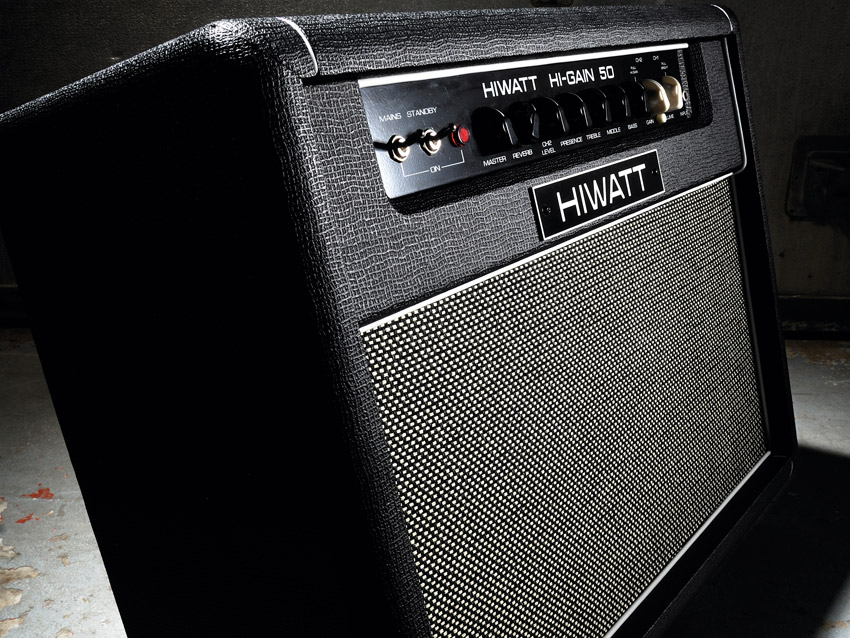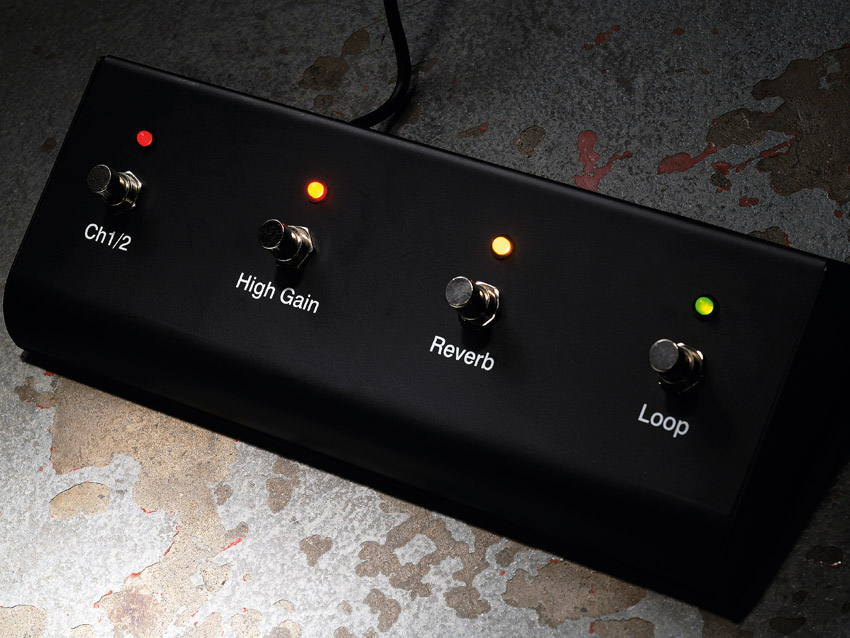MusicRadar Verdict
Sits among extremely tough competition, but the sounds and features here make the Hi-Gain 50 worthy of attention at this price.
Pros
- +
The compact design, the projection and the wealth of features
Cons
- -
Some compromise involved with the shared EQ section
MusicRadar's got your back



Hiwatt's part in British rock history is beyond doubt though, thanks to such legends as David Gilmour and Pete Townshend.
At the dawn of 2008, it's good to see the company's catalogue topped out with beautiful custom-made amps based on the same designs as those mighty heads used back in the day by Floyd and The Who. While it may be tempting to rest on those undeniably classic laurels and rich heritage, however, Hiwatt needs to move forward.
"We received lots of feedback from players who loved Hiwatt but wanted an amplifier with channel switching and access to gain," Hiwatt's Mark Lodge tells us. "The natural step was to give them what they wanted!"
This new 50-watt combo is part of the company's Hi-Gain Series that's designed with modern rock styles firmly at the forefront of channel two, full of cascading gain and crunching tones. Yet Hiwatt's characteristically strident, high-headroom clean sound is retained as the basis of channel one.
"When channel two is on there are three stages of amplification before the EQ," explains Mark. "That creates a lot of gain and distortion, so we implement a second volume control for channel two. This second volume helps you to get good distortion without the need to crank up the amplifier, and using channel two with the high gain function, some modifications are made to get even more distortion."
The amp's purposeful front panel bristles with chicken-head knobs that comprise a master three-way EQ plus a presence control, channel two's level and an all-important master volume. The pair of white knobs far right are for channel one's volume and channel two's gain.
The amp also offers an Accutronics spring reverb unit, controlled via the front panel. There are a number of push/pull functions: a bright switch for channel one and the high-gain hike for channel two. Completing the package, on the rear panel you also get a series effects loop and, usefully, all of these features are footswitchable - in addition to normal channel switching as you'd expect - via the four-way board that's happily included with the amp.
Sounds
Audio demo: the Hi-Gain 50's sounds in context:
Starting with a Stratocaster, it's clear that there's a great deal of power in these controls - you need to spend plenty of time familiarising yourself with their scope, as we found out. On the very first fire-up, channel two's basic rock tone seemed excessively bright, contrasted by a surprisingly lifeless clean channel, especially with the bass-heavy EQ settings we used to rein in the treble on channel two. Things improve quickly as the amp warms up, and indeed gets thrashed for a couple of weeks.
Winding the master all the way up and playing with channel two's gain pot rounds off some of the pointed edges of the tones to obtain a good AC/DC-style crunch that possesses that highly desirable ability to open out when you really hit the strings. Shrinking violets be aware: mid-frequencies like this can hit you like a jackhammer if you're not careful, but this is close to the classic tone for which Hiwatt is famous.
It's also important to point out that it's these strident mid frequencies that are going to get you heard at a rock gig: sure, they might sound a little angular in isolation, but they're utterly essential to punch your solos and riffs through a loud, busy band mix.
When hitting the high gain for additional heat, the tone squashes down a little more. This is a vintage-voiced high-gain tone though, so anyone hoping for mega-saturated Mesa Rectifier-type scoop should look elsewhere. But for classic Brit-flavoured rock - think Led Zep to Free, Thin Lizzy to The Who - a vintage-voiced bridge humbucker plugged in will bring on the smiles.
"The architecture of this circuit never will make the amplifier sound like a Mesa/Boogie, for example," Mark confirms. "This Hi-Gain series has a good sound, but it's not for those players who are looking for really heavy distortion using just the amplifier."
Mark's reference to "just the amplifier" begs for some stompbox experimentation, and of course you can shoot for any number of drive textures with the pedal of your choic.
Thanks to the Hi-Gain 50's high-headroom preamp, it takes to pedals very well indeed.
Channel one will break up into slight drive, but the headroom here is much higher, opening up all those huge, clanging, open-chord opportunities that a certain Mr Townshend loved so much. There's tons of volume on tap, and engaging the bright switch ushers in a shimmer and sparkle to take some of the squareness out of that solid, mid-range bark. The circuitry is said to come straight from Hiwatt's Custom Range, and anyone familiar with that tone will hear its clear lineage. Indeed if you prefer your cleaner moments to be full, with a tight bottom-end response and strong mids, you'll like this a lot.
Projection? No worries at all, even though the cabinet is slightly smaller than other UK-based 2 x 12s we could mention. The pair of Hiwatt speakers in this half-open enclosure really kick out the jams. Classic British amp tone is usually associated with Marshall or Vox, but plug this in, and you get a strong reminder of another key part of the story.
In these days of instant tone and immediate effects, it's refreshing to be confronted with an amp that demands a tussle before it'll react how you want it to. The Hi-Gain 50 does offer a good selection of tones, but don't expect to be able to simply plug in and go. Turn the master a long way up and then leave it there. Next, set your maximum gain levels in channel one and two, and work back from there because this is one of those dynamic beasts that reacts superbly to your guitar's volume pot, unlocking a plethora of tones and textures.
As is always the case with a shared EQ, compromise between the channels is inevitable, but the quality of channel one's clean and crunchy options outweigh the somewhat forced nature of channel two's higher gain.
If you're stepping up to the valve world from something like a Line 6 Spider, you're likely to find this undeniably vintage Hiwatt hard work at first. It doesn't sound all lovely and hi-fi, or mask your mistakes with super smooth gain. Instead it demands to played loud and proud in a band situation, and that your playing is well up to scratch. The payoff is that the Hi-Gain 50 will allow you to sound like you, rather than innumerable other players: high praise indeed.
With serious aural projection and a competitive price, we hope you'll give it a try and realise this is a musical instrument rather than a simple loud box.
MusicRadar is the number 1 website for music makers of all kinds, be they guitarists, drummers, keyboard players, djs or producers...
GEAR: We help musicians find the best gear with top-ranking gear round-ups and high- quality, authoritative reviews by a wide team of highly experienced experts.
TIPS: We also provide tuition, from bite-sized tips to advanced work-outs and guidance from recognised musicians and stars.
STARS: We talk to musicians and stars about their creative processes, and the nuts and bolts of their gear and technique. We give fans an insight into the actual craft of music making that no other music website can.
“This update reflects everything we believe modern gear should be”: Neural DSP gives the Nano Cortex an almighty power-up with free NanOS 2.0.0 system update
“It’s honestly got me thinking hard about adding one to my own studio set up”: Two Notes Reload II review
“Gloriously adorned with a gold edge burst finish over a gold paisley and sparkle top”: Gretsch unveils the Paisley Penguin – a rare bird that growls – and the Honey Dipper Special, a resonator for all your roots rock manoeuvres










